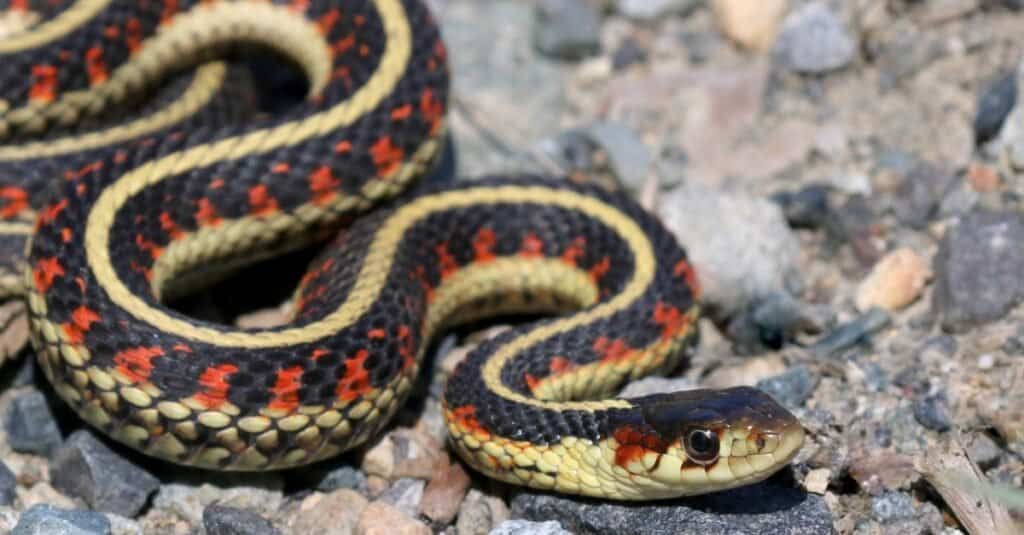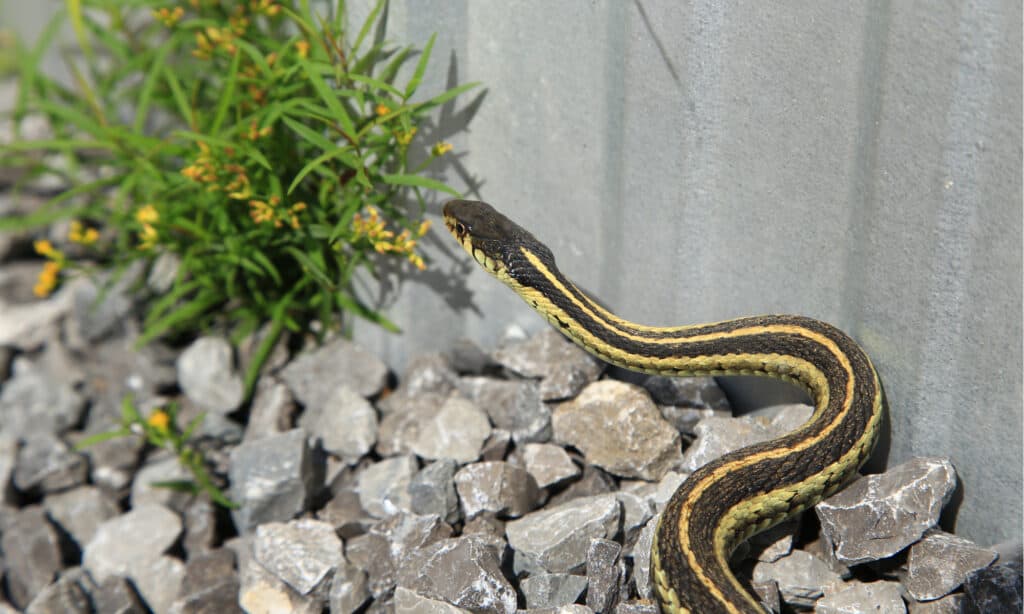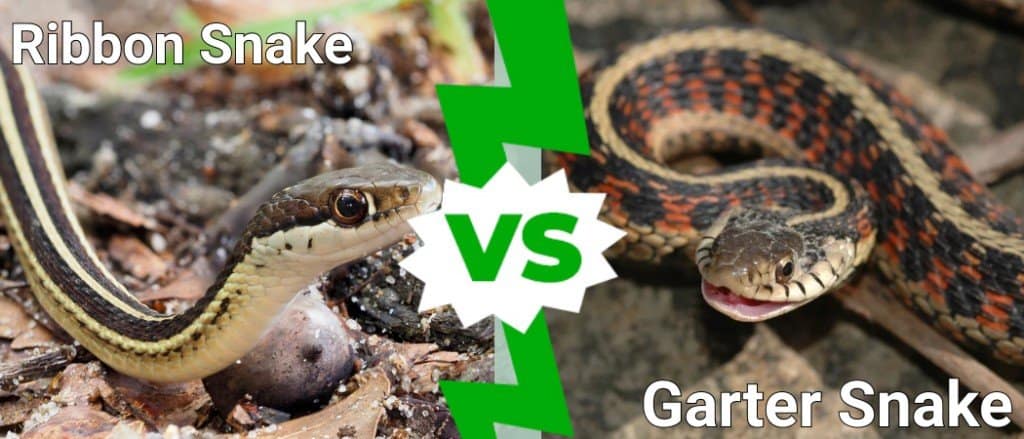What Do Garter Snakes Look Like? 3 Quick Ways to ID Them
There are approximately 35 species of garter snakes living in the United States. Amongst these species of garter snakes, there are ways to tell them apart from each other but for the sake of this article, we’ll focus on the general quick ways to identify garter snakes from other types of similar-looking snakes.
Garter snakes can be identified most easily by looking for the three light-colored stripes that run down the entire length of their back or sides. This resembles a garter which gives the snake their common name.
Continue reading to see the other quick ways of identifying garter snakes.
Stripes and Color

©iStock.com/randimal
There is a lot of variation available amongst garter snakes. Generally, they are black, brown, gray, or tan in color. Identifying garter snakes by color alone isn’t always helpful, so try to look for the presence of stripes to help. They will almost always have stripes, though sometimes they’re absent and other characters will need to be used for identifying the type of snake you’re looking at. For the stripes: one will be right down the middle of their back and the other two along their sides above their bellies. These stripes might appear checkered more than stripey, but the presence of three of them in the right orientation along its body is a good starting point for identifying a garter snake.
The color of the stripes also varies depending on the species. For example, the common garter snake (Thamnophis sirtalis) can have stripes that are yellow, green, blue, brown, or white. This is a lot of variation in one species! Another way you might be able to tell a garter snake from similar-looking snakes is the color of their belly. These snakes have a whitish-green or whitish-blue belly. In ribbon snakes, a lookalike to the garter snake, the belly is usually a yellowish or white color.
Scales

©iStock.com/rkhalil
You can use the appearance of the scales to help in identifying garter snakes, too. This might involve a closer look than you’re comfortable with, so always exercise caution when you’re around unfamiliar wildlife.
Snakes have dorsal scales and ventral scales. The dorsal scales are scales around the body of the snake, not including the scales of the underbelly. On a garter snake, these are somewhat raised on the ridges of the scale. This is called a “keeled” scale. The ventral scales are the larger scales on the underbelly and neck.
Additionally, the scales along the upper lip of the garter snake appear outlined in black. This is a pretty significant “tell” that you’re looking at a garter snake.
Range and Behavior

©Alexander Gold/Shutterstock.com
Garter snakes live anywhere in the US and in Canada with the exception of the arid regions of the American southwest. Along with their appearance, their general behavior can be indicative of what type of snake they are.
The garter snake is a snake that is more active during times when other snakes are inactive. Most snakes are nocturnal or crepuscular, meaning they’re most active at night or at dusk and dawn, respectively. The garter snake is an active snake during the day. Additionally, they’re active in a wider range of temperatures than many other snakes meaning they’re out longer in the season before they brumate. Brumation is like hibernation but for cold-blooded animals. They will usually brumate from October to April, but if you live in an area with mild winters, you might catch a garter snake basking during “unseasonable” times. Many other snakes will start brumation in September.
Their daytime activity and longer time before brumation is part of what makes it a commonly encountered serpent in the wild. Its preferred habitats are marshes, woodlands, and grassy environments. Many times they prefer to be by water.
What Snakes Are Mistaken For Garten Snakes?

The most commonly misidentified snake resembling a garter snake is a ribbon snake (Thamnophis sauritus). They’re very close relatives to garter snakes so it makes sense they are easily confused for each other. Identifying a garter snake compared to a ribbon snake can come down to those previously mentioned upper lip scales. The ribbon snake will not have defined upper-lip scales with a black outline like the garter snake does.
Additionally, a ribbon snake has a bit of white in front of their eyes, whereas a garter snake does not. If all else fails, you can judge them based on their shape. Ribbon snakes are more slender than garter snakes and tend to have longer tails. Garter snakes also have heads that are larger than their necks. Ribbon snakes have slightly more narrow heads.
Are Garter Snakes Venomous?
Garter snakes are non-venomous and generally are harmless creatures to humans and pets. They are shy snakes and will try to escape rather than attack. Garter snakes only tend to bite when provoked or handled. This can, of course, be an unpleasant experience so it’s best to just leave garter snakes to their business.
Are Garter Snakes Good To Have Around?
Garter snakes are pretty helpful to have in your garden or yard. They prey upon pests like rodents and slugs which can help keep your home free of these types of vermin and ensure your garden isn’t being attacked by slugs.
Since they’re nonvenomous and don’t pose a threat you pets and people, if you see a garter snake in your yard it is best to keep it around. If you’re opposed to this idea, you can put strongly scented plants around your house or garden. Plants like lemongrass, marigolds, or herbs like basil can deter snakes. Alternatively, you can use ammonia-soaked rags placed near hotspots to keep them from coming near your home or garden.
Discover the "Monster" Snake 5X Bigger than an Anaconda
Every day A-Z Animals sends out some of the most incredible facts in the world from our free newsletter. Want to discover the 10 most beautiful snakes in the world, a "snake island" where you're never more than 3 feet from danger, or a "monster" snake 5X larger than an anaconda? Then sign up right now and you'll start receiving our daily newsletter absolutely free.









